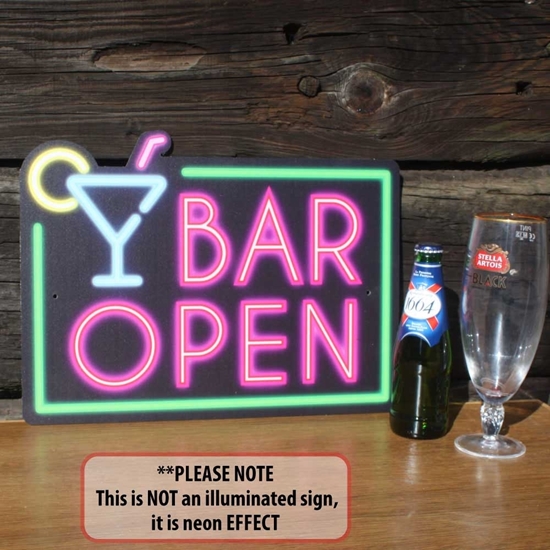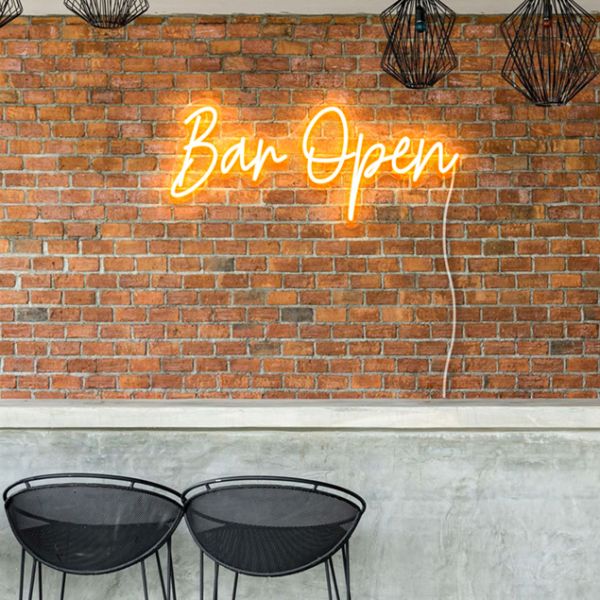Best Ideas For Selecting Pub Signs
Best Ideas For Selecting Pub Signs
Blog Article
What Is The Difference Between Bar Signs From Each Other In Terms Of Their Purpose?
The reason for bar signs is a bit different. There are a few significant differences between bar sign. Branding
Purpose of this logo: To help strengthen and grow the bar brand.
Features: Often includes the bar's logo, name and the signature colors. The concept is to reflect the theme and feel of the establishment.
Custom-designed metal signs with the bar’s name and logo.
2. Information
The purpose of this newsletter is to provide patrons with important details about the bar.
Features: Clear text with clear information on hours of operations, WiFI passwords, home rules or toilet locations.
Signs pointing out restrooms, or hours of operation on a wall near the entryway.
3. You can also find Decorative items on Decorative
Goal: To improve the visual appeal and ambiance of the bar.
Features: More artistic or thematic, contributing to the overall design of the bar. It is not allowed to include text or particular information.
Examples: Beer advertisements from the past funny or quirky signs and themed art.
4. Promo Codes
Goal: To advertise products, events, or specials.
Features: Design with attractive graphics that showcase special offers or events coming up. They may also include seasonal or re-usable elements.
Examples: chalkboards with daily specials, banners promoting Happy Hour deals; posters for upcoming event.
5. Directional
Guide patrons in the bar.
Features: Clear arrows and instructions for customers to navigate the bar area, for instance getting to the bathrooms, exits or various areas of the bar.
Examples: Arrows for direction for various seating areas.
6. Regulatory/Compliance
The purpose is to comply with legal requirements, and also to ensure safety.
The sign must be required to ensure that it fulfills legal obligations. For instance, it can indicate the smoking zone and occupancy limit or emergency escapes.
Signs that prohibit smoking, restrict occupancy, or alert of emergency exits are examples.
7. Interactive
The goal of the project is to engage customers through an engaging experience.
Features: Element that encourage patron participation, like surfaces that you can write on, or use digital interactions.
Signs that have QR Codes linking to digital menus (or social media) or chalkboards that allow customer messaging are examples.
8. Thematic
Goal: To create a certain style or atmosphere.
Features: Signs which align with the theme of the bars, contributing to an overall experience and atmosphere.
Examples: Pirate themed signs in an nautical themed bar and rustic wood signs an a country bar.
9. Menu
Purpose: To show the bar's menu of food.
The list of foods and beverages is usually clearly listed, along with their costs. The list can be static, or change.
Examples Screens that are digital and display the menus in rotation, or wall-mounted drink menus.
Every bar sign is designed to fulfill a specific purpose. Its design is based on its role within the bar. By understanding the differences, bar managers will be able to choose and place the signs in a way that enhances their patrons’ experience and meets the requirements of their business. View the recommended bar signs examples for blog tips including pub sign design ideas, bar sign hanging, home pub signs, design a pub sign, hanging pub signs for garden, personalised outdoor bar signs, home made bar sign, the pub sign, pub signs to buy, design a pub sign and more.
How Do Bar Signs Differ With Regards To Lighting?
The lighting of bar signs can alter their ambiance, visibility and their overall impact. Here are some key ways that bar sign lighting could be affected: Neon Signs
Characteristics: Bright, colorful, classic.
Lighting: Make use of neon gas-filled tubes that emit light when charged.
Uses : Ideal to create an aged, retro-style look. Useful to create logos and bar names.
Benefits: It's very visible from an extended distance.
The material is brittle and costly to repair.
2. LED Signs
Characteristics: Energy-efficient, versatile, modern.
Lighting: Light-emitting Diodes (LEDs) create a bright, vibrant and bright illumination.
Uses: Great for indoor and outdoor signage, display systems that can be programmable and lighting effects that are dynamic.
Benefits: The LEDs are long-lasting, efficient in energy use, and can be programmed to show colors or animations.
Disadvantages : Can be costly initially, but it can also help you save money on maintenance and energy costs.
3. Backlit Signs
Characteristics: Elegant, sophisticated, subtle.
Lighting: Uses lighting with fluorescent or LEDs behind a translucent surface to create soft light.
Uses : Commonly used on modern bar signs, menu boards, and branding elements.
Benefits: Increases the readability of small print in dim lighting conditions.
Advantages: Easy installation, but a higher initial cost.
4. Signs Edge-Lit
Characteristics: Sleek, contemporary, stylish.
Lighting Use LEDs to highlight the edges of a sign, typically acrylic.
Applications: Ideal for contemporary minimalist designs.
Benefits: Energy efficient, gives a distinctive and sophisticated appearance.
Advantages: Only available in certain designs.
5. Ambient/Accent Lighting
Characteristics: Subtle, atmospheric, decorative.
Lighting Direct lighting is used to emphasize or highlight indications.
Applications for this product The product can be used to enhance the ambience and is frequently used to emphasize themed decor or artwork.
Benefits: It adds the ambience and depth, and can create a welcoming and warm atmosphere.
Disadvantages: May not be able to provide enough direct illumination for reading.
6. Marquee Signs
Characteristics: Bold, theatrical, eye-catching.
Lighting: Light up the sign with multiple LEDs or bulbs.
Uses: Signs on the outside, event promotion, and vintage-style cinema are popular.
Attractive and well-lit.
The downside is that it can be expensive and requires regular maintenance.
7. Projection signs
Characteristics: Dynamic, innovative, versatile.
Lighting: Make use of projectors to cast light and images onto the surface.
Uses: Perfect for promoting events, temporary displays, and other displays that are dynamic.
Simple to alter There is no need to use physical signs.
Advantages: Needs a controlled lighting system, may not be as effective in bright lighting.
8. Fluorescent Signs
Characteristics: Bright, cost-effective, traditional.
Lighting Tubes with fluorescent light used for illumination.
Applications: Typically used on larger indoor and exterior signs.
Advantages: Bright, effective and cost-effective for large signage.
Disadvantages
Lighting Considerations
Visibility
Neon and LED Signs are great for attracting attention who are far away, particularly when it's dark.
Backlit and edge-lit signs improve readability and give a an elegant appearance.
Energy Efficiency
LED Signs are energy efficient and lasts for a long time.
Neon and fluorescent signs: Neon is less energy-efficient.
Aesthetic Appeal
Neon and Marquee Signs: Perfect for retro and vintage styles.
For modern, clean designs, edge-lit or backlit signs are the best choice.
Ambient Lighting: Enhances the general atmosphere and ambience.
Maintenance
LED signs are easy to maintain and durable.
Fluorescent and neon signs: Require more frequent maintenance and potential repairs.
Cost
LED and Backlit Signs: Higher upfront costs but lower operational costs.
Signs made of fluorescent are cheaper initially, but they consume more energy over the long run.
Flexibility
Projection LED Signs as well as LED Signs that can be programmed Provide flexibility and high-dynamic content for display.
Traditional Signs: They are more rigid, however they usually achieve a certain appearance.
When choosing the best type of lighting for bar signs, bar owners can enhance their bar's visibility, establish the desired atmosphere and effectively promote their company's name and promotional messages to customers. See the top home pub signs advice for site info including pub signs personalised, personalised pub, personalised metal pub signs, novelty bar signs, personalised metal bar signs, buy bar signs, gin bar sign, small pub signs, cocktail bar sign, pub signs and more.
What Are The Differences Between Bar Signs And Regulations?
There are numerous regulations that apply to bar signs. They include state, local and federal laws to ensure the safety of people and to ensure aesthetic standards. Below are the different types of signs for bars that are subject to different regulations: 1. Dimensions and Placement Regulations
Zoning laws: These regulations dictate the size the height, distance and location of signs that are visible from roads, property lines or adjacent buildings.
Historical Districts: Restrictions could apply to preserve the historical characteristics of specific areas restricting the size, design, and materials of signs.
2. Illumination Restrictions
Light Pollution: Regulations may limit the brightness, color and time of signs that are illuminated to reduce light pollution while also preserving the nighttime atmosphere.
Safety Considerations Signs cannot create glare and should not be distracting for drivers or pedestrians especially when they are located near the road.
3. Signage Content
Alcohol Advertising Certain jurisdictions have strict rules on alcohol-related advertising that prohibit certain types of content or imagery that may attract minors or encourage excessive consumption.
Health Warnings - Laws may require the prominent display of health warnings and signs regarding alcohol consumption or smoking.
4. Historic Preservation Regulations
Architectural Compatibility: Signs in historic districts must be compatible with the style and design of the region, typically requiring approval from preservation boards or commissions.
Design and Materials - Restrictions could be placed on design, designs, materials, or color schemes to guarantee the integrity of historical records.
5. Sign Permitting Process
Permits are needed: Owners of bars must get permits to install or modify signage. This could require submitting drawings, and paying fees, as well having approval from the local authorities.
Code Compliance: Signs must to comply with building codes as well as fire safety rules, as well as accessibility standards to protect the public and provide accessibility to people with disabilities.
6. Sign Removal Repair, Maintenance and Removal
Maintenance Requirements. Bar owners have the responsibility of keeping signs in good working order, making sure they are free from hazards and conforming with rules and regulations.
Signs that are abandoned or damaged: In order to avoid destruction and to preserve the aesthetics in an area, there may be regulations governing the removal of signs that have been abandoned or dilapidated.
7. Digital Signage Regulations
Content Restrictions: Laws can restrict the content that is shown on digital signage, for example by prohibiting flashing lights and images that are offensive.
Operational limits: Regulations can limit the brightness, speed, or frequency at the point that digital signs alter to minimize visual clutter.
8. Penalties and enforcement
Inspections. Local authorities conduct regular inspections of signs to ensure the compliance. Citations for violations are issued.
Penalties. For non-compliance there may be citations, fines, orders to modify or remove signs, or legal actions.
9. Signing Variance Process
Variance applications bar owners who wish to alter their signage in accordance with the rules can do so by applying for a variance. Justification should be provided along with any adverse impact on the public's security or appearance should be considered.
Public Input: Some variations may require community input for instance, public hearings or feedback from property owners and businesses associations, or even remarks from members of the community.
10. Community Engagement and Input
Public Consultation. Certain jurisdictions allow citizens to be part of the development of sign regulations through surveys and public meetings.
Community Benefits: Sign regulations can include provisions that improve the quality of signage or promote local businesses. It can help in the revitalization of neighborhoods.
By understanding and complying with signage regulations Bar owners can ensure that their signs enhance the aesthetic appeal of their establishment. improve the overall appearance of the community, and meet legal requirements, while reducing the possibility of fines or penalties, as well as legal disputes. Read the top window vinyl url for website advice including pub wall sign, signs for the bar, pub signs to buy, personalised outdoor bar signs, bar signs for home bar, hanging bar sign, the staying inn bar sign, pub wall sign, cocktail bar sign, personalised metal pub signs and more.